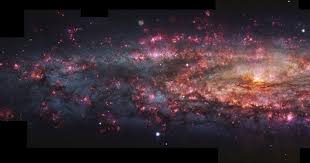
Zooming into the Cosmos: Sharpest-Ever Image of Sculptor Galaxy Unveiled

 :
| Updated On: 21-Jun-2025 @ 1:44 pm
:
| Updated On: 21-Jun-2025 @ 1:44 pmSHARE
Astronomers have recently captured one of the most vivid and detailed images of the Sculptor Galaxy (NGC 253), a barred spiral galaxy located approximately 11 million light-years away from Earth. The Sculptor Galaxy bears a striking resemblance to our own Milky Way in terms of its shape, size, and mass. This new achievement adds a significant chapter to the long-standing effort by astronomers to observe and document the wonders of deep space.
The research was led by Enrico Congiu at the European Southern Observatory (ESO) and is part of a new study published in Astronomy & Astrophysics. Congiu emphasized that the Sculptor Galaxy offers a unique observational advantage: it is close enough for astronomers to resolve its internal structures in remarkable detail, while also being large enough to be studied as a complete galactic system. This dual perspective enables astronomers to analyze both individual stellar regions and the larger galactic framework simultaneously.
To create this ultra-detailed map, researchers used the Multi Unit Spectroscopic Explorer (MUSE) instrument mounted on ESO’s Very Large Telescope in Chile. The galaxy was observed for more than 50 hours, and over 100 exposures were meticulously stitched together to form a complete image spanning an area 65,000 light-years across. Unlike conventional galaxy images that depict a limited color range, this new image showcases thousands of colors. Each color represents different wavelengths of light emitted by various components of the galaxy—stars, gas, and dust—offering invaluable insights into their age, composition, and motion.
One of the key revelations from this high-resolution image is the ability to zoom in to nearly the scale of individual stars and observe star-forming regions in exceptional detail. At the same time, researchers can zoom out to study the broader galactic structure. This dual approach is rare and makes the image a powerful tool for both micro and macro-level studies of galactic phenomena.
The data has already yielded remarkable findings. Astronomers have identified over 500 new planetary nebulae—luminous shells of gas and dust expelled by dying stars. These nebulae not only enrich our understanding of stellar evolution but also serve as markers to help verify the galaxy’s distance from Earth, which is crucial for broader studies of galactic dynamics and cosmology.
Moreover, the image captures shells of gas and dust released during the late life stages of stars, particularly as they approach the red giant phase. These observations help scientists understand how stellar death contributes to the chemical enrichment of galaxies, influencing the birth of new stars and the galactic life cycle.
This is not the first time Sculptor Galaxy has been observed; the Hubble Space Telescope captured detailed imagery of it back in 1998. However, the current image surpasses previous ones in detail and spectral richness. The galaxy, like the Andromeda Galaxy, is incredibly bright and massive, and can be spotted using binoculars under ideal night-sky conditions.
In the coming years, astronomers plan to use this detailed map to explore how gas flows within the galaxy and how it evolves to create new stars. This breakthrough image stands as a milestone in galactic imaging and offers a treasure trove of data for future astronomical studies.